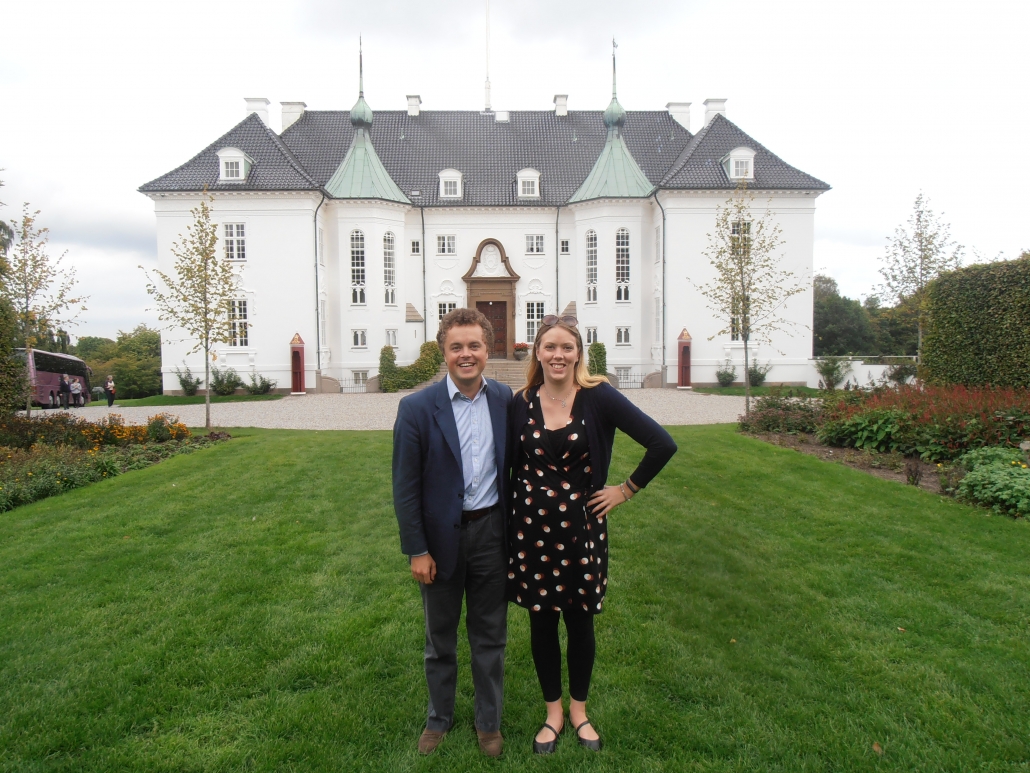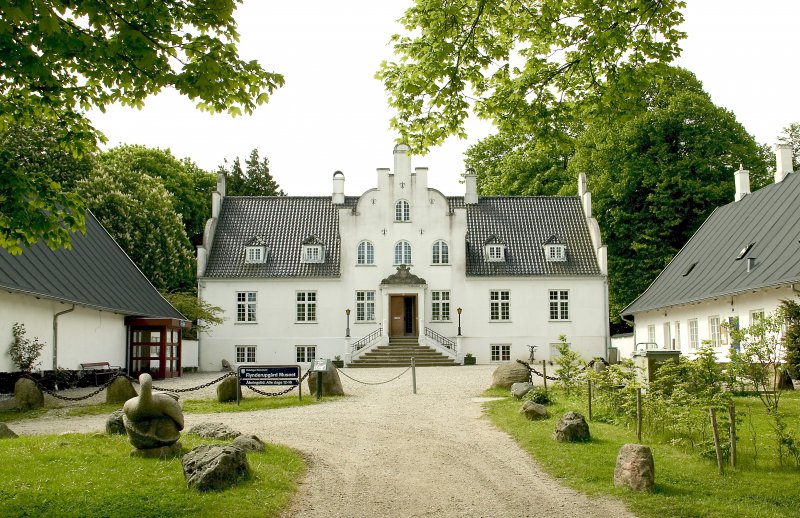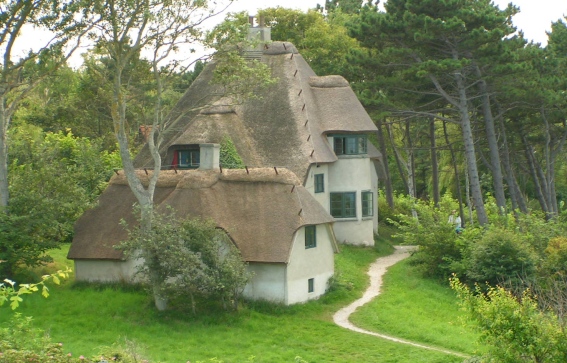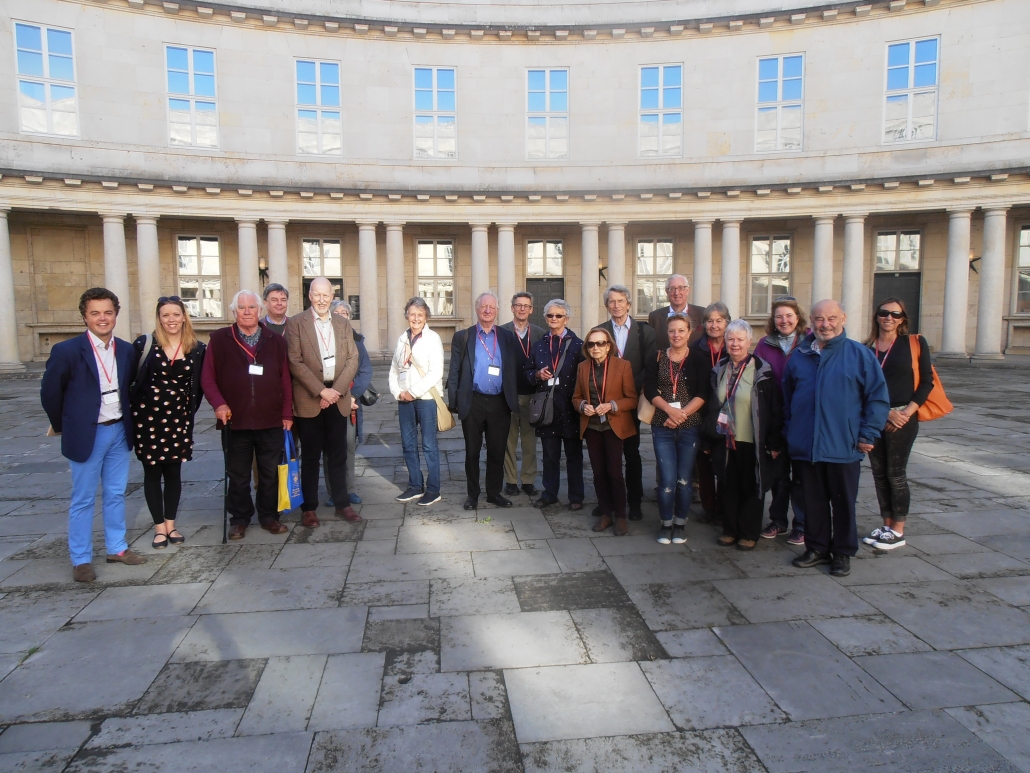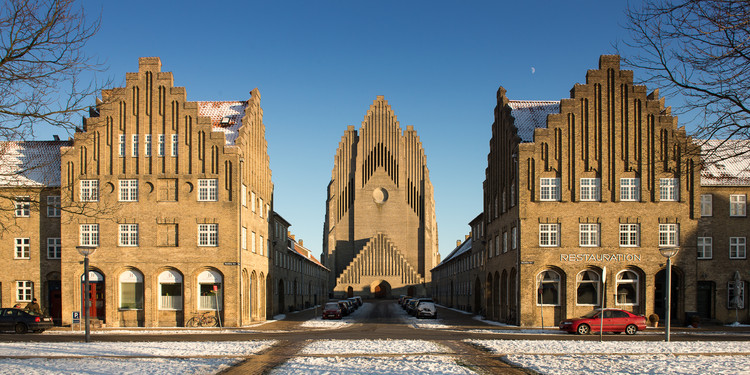Robbie Kerr and Rebecca Lilley in front of Marselisborg Palace, Queen Margrethe II’s summer residence © Rebecca Lilley
Country house Flynderupgård whose main building was adapted in its current style from 1915 to 1920 (architect not known)
Explorer Knud Rasmussen’s thatched cottage of 1916 to 1918
by Helge Bojsen-Møller
The tour group in the central courtyard of the Police Headquarters by Hack Kampmann in Copenhagen © Rebecca Lilley
Grundtvig’s Church of 1924-1940 by Peder Jensen-Klint
Study Tour of Denmark
14 September to 19 September, 2018
By Michael Barker
We assembled first in a hotel close to the town of Roskilde, west of Copenhagen, in the province of Zealand, for our tour of Denmark — which had been suggested by Queen Margrethe II — to look at the works of the Danish contemporaries of Edwin Lutyens, and she had kindly invited us to visit her summer residence, Marselisborg Palace in Aarhus. As this is never open to the public, this was a real privilege.
The tour began on Saturday morning with a visit to the immense, splendid cathedral, Denmark’s first Gothic church, built from brick in 1170. It is French-inspired, with porches added in the 15th century and later chapels to accommodate the astonishing range of royal tombs of Danish monarchs, dating from the 15th century until recent times and elaborately carved in marble in a Renaissance style by Dutch artists, in a Neoclassical style or, in the 1950s, simply in austere stone. Of particular note was the contribution of Hack Kampmann, an important architect of the 1900s. There was much to see here, with vivid frescoes, a superb gilded baroque organ, a beautifully ornate 17th-century pulpit and even modernity in the shape of recent wrought-iron screens and the King’s bronze entrance doors decorated with much Symbolist detail.
Then a coach took us to Mikkelborg to see Mikkelgård, the former summer retreat of composer Hakon Schmedes, built in 1915 to 1916 to a design by Povl Baumann in the Arts and Crafts style and now a restaurant. Typically low-built with red elevations, the inevitable pink pantiled roofs and small-paned and dormer windows, it is set in open grounds facing the sea, looking towards Sweden. Baumann also sculpted the sandstone figures at its entrance. After a copious, five-course lunch based on 1920s recipes, we visited Flynderupgård, a former farmhouse converted into a country house at the beginning of the 19th century. Situated in an area of traditional farming, it is now a museum with a handsome painted timber staircase and a sculpture garden.
On a remote hilly site facing the North Sea is the attractive thatched house, resembling a large English cottage, of explorer Knud Rasmussen, built in 1916 to 1918 by Helge Bojsen-Møller. Its untouched, intimately furnished interior has great charm.
Our last stop of the day was Munkeruphus near Munkerup, built in 1916 by Terkel Hjejle and Niels Rosenkjaer. Its grey-painted, timber-clad elevations with typical small paned windows have a more formal charm in an almost English Neo-Georgian style, although its upper floor is slightly jettied. It was occupied by the designer and sculptor Gunnar Aagaard Andersen from 1958 and displays some of his avant-garde furniture and design. It is now also a contemporary art space.
On Sunday we took the train from Roskilde to Copenhagen, arriving at the city’s gigantic Central Station by Heinrich Wenck in the National Romantic Style, which opened in 1911. Here we encountered the Danish predilection for exterior sculptures of fantastical figures of humans and animals and the imaginative use of decoration in brick, the principal national building material.
Our tour of the Police Headquarters was a triumph, led by an excellent guide. Its austere, external Neoclassical elevations of 1918 by Kampmann conceal his delightful, circular inner courtyard, again purely Neoclassical. Inside, in a huge, tall space with giant Corinthian columns is a war memorial to the police who suffered during the Nazi occupation in World War II, which features a giant sculpture, The Snake Killer by Einar Utzon-Frank. We then discovered that after Kampmann’s death in 1920 his young successors created stunning Art Deco interiors, notably in the police chief’s office. Also remarkable here — and almost everywhere — was the Danish attention to outstanding inlaid floors of immense variety.
The enormous Copenhagen City Hall by Martin Nyrop in the National Romantic Style, completed in 1905, entailed a lengthy exploration – Denmark, although a small country, goes in for huge buildings. Among City Hall’s attractions were Nyrop’s attention to interesting detail, from door handles to colourful ceramics and the magnificent staircase with Art Nouveauish plasterwork depicting seagulls in flight. In its main hall are sculptures of important Danish figures, including Hans Christian Andersen.
Soon after, we passed Anton Rosen’s very impressive Palace Hotel of 1910 nearby — in a sort of Nordic Art Nouveau style — with its tall tower bearing a mosaic, gilded wrought-iron balconies and typically elaborate brickwork (sadly its interiors have not survived). We then lunched very satisfactorily at the Hereford Village restaurant, crammed with visitors from Asia. A coach tour followed in the suburbs of Copenhagen; we visited Studiebyen with its simple public housing of 1920s low-built terraces, typically with small-paned windows and dormers, and detached buildings, followed by Svanemøllevej with its grand villas in a plush area with numerous embassies and consulates. On the way we spotted Rosen’s former Tuborg Brewery offices in a pure Arts and Crafts style. One noticeable villa was the eccentric Arts and Crafts-cum-Art Nouveau house by Carl Harald Brummer of 1904, which demonstrates an imaginative use of intricate and decorative brick detail.
The huge Grundtvig’s Church by Peder Jensen-Klint is a rare, wonderful example of Expressionist architecture, all in yellow brick. It was inaugurated in 1927 but additions were made to it by his son Kaare Klint after 1930. Its tall, striking west facade is utterly memorable. Its luminous interior is a modernist, unadorned version of the Gothic.
At Bakkehusene in Bellahøj is another garden suburb of public housing of the 1920s in the local vernacular by Ivar Bentsen and Thorkild Henningsen. Our last stop that day was the red-brick church of Godthaab of 1911 by Gotfred Tvede, a worthy building, if a bit austere. Its most striking features were a Christ on the cross surrounded by dashing angels by sculptor Carl Mortensen above a very fine ceramic altar by Herman Kahler. Then it was a cross-country journey to Aarhus, Denmark’s second city, in Jutland.
On Monday there was a guided tour, first passing the Central Station in a rather old fashioned Classical style with giant Ionic columns, of 1927, by Knud Seest. The former Custom House on the harbour front is a major work of 1898 on a huge scale by Kampmann — a tall central tower, flanked by two lower towers and featuring sculptures, although its interior has largely been lost. Nearby, by contrast, is the delightful “red building” of the Cathedral School of 1904, also by Kampmann and in a pure Art Nouveau style with excellent lettering. Adjoining this is the charming “white building” of 1763. Further on, opposite the ancient cathedral which we did not visit, is Kampmann’s enormous Aarhus Theatre built from 1898 to 1900 in an Art Nouveau style tinged with National Romanticism, alas closed for renovation. Its facade has a colourful frieze and its pediment is decorated with figures in theatrical costume. Close to this is the former Post and Telegraph building of 1904, again by Kampmann but this time in a Classical style with pilasters and enlivened by bizarre ornamentation. Adjoining this is an attractive religious building, its porch decorated by a huge bronze eagle. Nearby, too, were picturesque, half-timbered ancient buildings.
The next destination was Aarhus University, founded in 1928, whose principal architects were CF Møller, Kay Fisker and Povl Stegmann. Regarded as a major work of Danish functionalist architecture, it is in a large park with lovely trees and duck ponds. The City Hall, designed by eminent architect Arne Jacobsen in collaboration with Erik Møller, was inaugurated in 1941. A curious modernist building clad in grey marble with a tall clock tower, it has a spacious main hall with an elegant curving staircase, rich, dark oak parquet and ceramic inlaid floors, specially designed furniture by Hans Wegner, light fittings and sophisticated wooden acoustic walls. Its impressive council chamber is expensively panelled in Cuban mahogany and its outer wall boasts a huge, jolly mural of naked citizens enjoying themselves by Thorvald Hagedorn-Olsen. The wedding hall, decorated with pretty flower paintings, is more recent.
On the outskirts of the city is Den Gamle By, an open-air museum of 75 historic buildings re-erected very effectively in the form of an old town with winding, cobbled streets. After a packed lunch of delicious open sandwiches we enjoyed visiting its picturesque, often half-timbered buildings, the earliest dating from 1550, and a grand 18th-century Mintmaster’s Mansion. There are also an ironmonger, bookshops, a bakery, jeweller, vintage cars in an old workshop and museums of toys, pottery and posters. Little wonder this entertaining place is so popular.
South of Aarhus is Villa Kampen built between 1901 and 1902 by Kampmann as his home and partly inspired by Charles Voysey. Now offices, its spacious interior has a handsome, original staircase below a vivid Art Nouveau stained-glass window. Then came our visit to Queen Margrethe’s summer residence, set in a large park, ably guided by its administrator. Designed by Kampmann — and built from 1899 to 1902 on two floors with cross-windows plus a tall hipped roof with dormers — its 11-bay white rendered entrance facade is in a late 17th-century style although it is flanked by two towers, typical of 1902. The ground floor’s reception rooms are comfortably furnished with much modern art and ceramics, while the fireplaces may date from 1967 when the Queen was given the house by her father. The staircase is a typically Hackmann design with a ceiling adorned with birds, reminiscent of that in Copenhagen’s City Hall. The east elevation with its pediment crowded with sculptures is a 1902 version of the 18th-century, although with delightful, inventive wrought-ironwork. In the grounds are intimate gardens with modern sculptures.
Our coach then took us back to Zealand where we stayed at the hotel, Nykobing Falster. Tuesday morning was spent at the Danish Agency for Culture and Palaces where we saw a slide show introduction of Danish architecture from 1880 to 1940. It was followed by an urbane presentation of Lutyens’s architecture by Martin Lutyens. Robbie Kerr and Rebecca Lilley then offered an overview of our tour. After lunch at the agency we took the coach to stay at the Hotel Marriott in Copenhagen before an evening reception at the British Embassy as guests of ambassador Dominic Schroeder with welcome drinks, a buffet and another presentation given by Martin.
On our last day we visited the Unitarian Church, an austere building of 1927 by Carl Brummer, in stone for once, although its internal balcony is elegant. It was funded by the widow of composer Edvard Grieg. The Freemasons’ Grand Master’s Lodge of 1923 by Holger Rasmussen has a plain exterior but its entrance has distinctive, giant Ionic columns. The well-kept interior has huge reception rooms, one bearing shields of past members and the Grand Master’s fine throne.
Many of us chose as our last visit Ny Carlsberg Glyptotek, the vast art museum founded by Carl Jacobsen, son of the famous brewery’s founder. Its architects were Vilhelm Dahlerup (1897 and 1906), who contributed to its lavish, historicist style, and Kampmann (1906), responsible for its more simple Neoclassical style. There was much to see: ancient sculptures, Danish Golden Age paintings and Danish and French sculptures, the latter acquired in Paris.
The group had lunch at the restaurant Axelborg Bodega, then dispersed after five interesting, action-packed days, amply researched by Paul Waite and ably led by Rebecca and Robbie, armed with copiously illustrated notes.
Three members later contacted The Trust with their comments about the tour, and we thank them for this feedback. Here are their thoughts: “I enjoyed the trip hugely and loved our privileged access to the Police Headquarters and Marselisborg Palace,” wrote one member. “It was a very convivial group, the sights very varied and fascinating and the weather glorious. I’m grateful to Rebecca and Robbie for all their hard work in organising such a splendid event.” Another member said: “We had a delicious 1920s style lunch served by suitably costumed staff. This was in an adjacent building, a restaurant called Spisestuen that served ‘plain Danish home-cooking from the good old days’. Our lunch included herring, breaded fish, pork medallions with onion rings, brie, home-made jam and rye bread. Only one slice of white bread was served because this was more expensive in that period. A real piece of authentic social history.”

